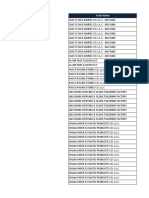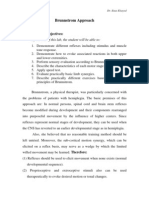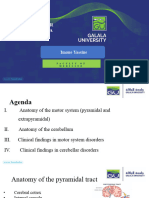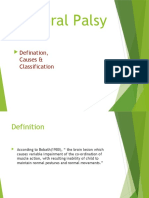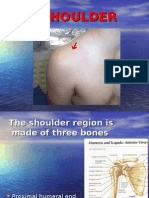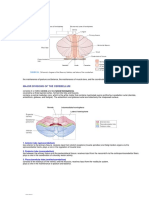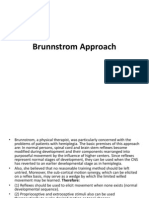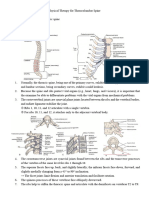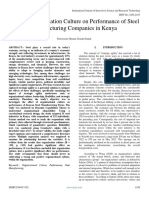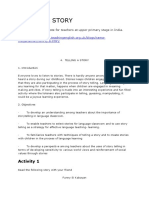0 ratings0% found this document useful (0 votes)
25 viewsNeocerebellar Syndrome
Neocerebellar Syndrome
Uploaded by
goldengoal19079This document discusses the manifestations of neocerebellar syndrome. It outlines several symptoms: 1) hypotonia and muscle weakness, 2) motor ataxia characterized by dysmetria, dysarthria, disturbed gait, dysdiadokokinesia, decomposition of movement, rebound phenomenon, and kinetic tremor, 3) cerebellar nystagmus, which is involuntary eye movement. It provides definitions and descriptions of each symptom, explaining they result from failure of the cerebellum's role in damping, timing, predictive and smooth progression of movement. Tests like finger-to-nose are used to examine dysmetria, while heel-knee assesses decomposition of movement.
Copyright:
© All Rights Reserved
Available Formats
Download as PPTX, PDF, TXT or read online from Scribd
Neocerebellar Syndrome
Neocerebellar Syndrome
Uploaded by
goldengoal190790 ratings0% found this document useful (0 votes)
25 views14 pagesThis document discusses the manifestations of neocerebellar syndrome. It outlines several symptoms: 1) hypotonia and muscle weakness, 2) motor ataxia characterized by dysmetria, dysarthria, disturbed gait, dysdiadokokinesia, decomposition of movement, rebound phenomenon, and kinetic tremor, 3) cerebellar nystagmus, which is involuntary eye movement. It provides definitions and descriptions of each symptom, explaining they result from failure of the cerebellum's role in damping, timing, predictive and smooth progression of movement. Tests like finger-to-nose are used to examine dysmetria, while heel-knee assesses decomposition of movement.
Copyright
© © All Rights Reserved
Available Formats
PPTX, PDF, TXT or read online from Scribd
Share this document
Did you find this document useful?
Is this content inappropriate?
This document discusses the manifestations of neocerebellar syndrome. It outlines several symptoms: 1) hypotonia and muscle weakness, 2) motor ataxia characterized by dysmetria, dysarthria, disturbed gait, dysdiadokokinesia, decomposition of movement, rebound phenomenon, and kinetic tremor, 3) cerebellar nystagmus, which is involuntary eye movement. It provides definitions and descriptions of each symptom, explaining they result from failure of the cerebellum's role in damping, timing, predictive and smooth progression of movement. Tests like finger-to-nose are used to examine dysmetria, while heel-knee assesses decomposition of movement.
Copyright:
© All Rights Reserved
Available Formats
Download as PPTX, PDF, TXT or read online from Scribd
Download as pptx, pdf, or txt
0 ratings0% found this document useful (0 votes)
25 views14 pagesNeocerebellar Syndrome
Neocerebellar Syndrome
Uploaded by
goldengoal19079This document discusses the manifestations of neocerebellar syndrome. It outlines several symptoms: 1) hypotonia and muscle weakness, 2) motor ataxia characterized by dysmetria, dysarthria, disturbed gait, dysdiadokokinesia, decomposition of movement, rebound phenomenon, and kinetic tremor, 3) cerebellar nystagmus, which is involuntary eye movement. It provides definitions and descriptions of each symptom, explaining they result from failure of the cerebellum's role in damping, timing, predictive and smooth progression of movement. Tests like finger-to-nose are used to examine dysmetria, while heel-knee assesses decomposition of movement.
Copyright:
© All Rights Reserved
Available Formats
Download as PPTX, PDF, TXT or read online from Scribd
Download as pptx, pdf, or txt
You are on page 1of 14
)-( LECTURE NO
Neuro-Physiology
Kamal Mohammed
Lecturer Of Physiology
Neocerebellar
syndrome
Faculty Of Medicine Head Dept.Of Physiology
Manifestations
1. Hypotonia:
• with subsequent pendular knee jerk.
• there is muscle weakness because there is
difficulty in maintenance of muscle
contraction.
Motor (cerebellar) ataxia
2. Motor (cerebellar) ataxia is manifested by:
1-Dysmetria:
• Definition: inability to adjust the movements
to a certain distance.
• Types:
a. Hypermetria: overshoot of movement.
b. Hypometria: stop short before its aim.
• Cause: failure of damping and timing
functions of the cerebellum.
• Examination: by finger to nose test.
2-Dysarthria:
• Definition: difficulty in producing clear
speech, due to failure of smooth progression
and prediction of movements in muscles of
larynx, mouth, and respiratory muscles.
• Characters: the volume of sound is not
controlled; it is either loud or weak speech
with tendency to hesitate at the start of word
(as Aaa..lll.eee.xxx..aanddria).
3-Disturbance in gait:
• the patient walks in a zigzag manner and tend
to fall toward the affected side.
3-Dysdiadokokinesia (adiadokokinasia
):
• Definition: it is the inability to perform
rapidly alternate opposite successive
movement like supination and pronation.
• Cause: failure of predictive and smooth
progression function of the cerebellum.
4-Decomposition of movement:
• Definition: the patient has difficulty in
performing simultaneous movements at more
than one joint.
• Character: patients dissect the movements
and carry them one joint at a time.
• Examination: by heel – knee test
5- Rebound phenomenon:
• Definition: an overshooting of a limb when a
resistance to its movement is removed.
• Normally: flexion of the forearm against
resistance is checked when the resistance is broken
off.
• In cerebellar disease: the patient cannot stop
movement of the limb and the forearm flies
backward.
• Cause: inability to stop the movement.
6-Kinetic (intention) tremor:
• Definition: when a person performs a
voluntary act, the movements oscillate back
and forth at the intended point, because
overshooting of the movement at the intended
point cause the motor cortex to correct the
overshooting by an opposite movement, which
again overshoot to the other side.
• Characters:
i. It continues until the movement finally settles
to the intend mark.
ii. It appears when the patient performs
voluntary action.
iii. It is absent at rest.
7-Cerebellar nystagmus:
• Involuntary, rapid oscillation of the eyeballs in
a horizontal, vertical, or rotary direction, with
the fast component maximal toward the side of
the cerebellar lesion.
• secondary to tremors in extraocular muscles.
Testing of coordination of voluntary
movements
1-Eyes open or closed:
I. Cerebellar ataxia is not improved by visual
orientation.
II. Sensory ataxia (from dorsal column disease)
is worsened with closed eyes.
Thanks
You might also like
- GUNDAM Series (Pack 1) - Mobile Suit 0079, MSG Zeta, ZZ, 7 Movies - 720p DUAL Audio x264Document3 pagesGUNDAM Series (Pack 1) - Mobile Suit 0079, MSG Zeta, ZZ, 7 Movies - 720p DUAL Audio x264julia_jayronwaldoNo ratings yet
- منتجات القطاع الصناعي في إمارة أبوظبيDocument656 pagesمنتجات القطاع الصناعي في إمارة أبوظبيAgro Export and importNo ratings yet
- Brunnstrom ApproachDocument9 pagesBrunnstrom Approachavtordaj100% (1)
- Incomitant SquintDocument41 pagesIncomitant Squintshreeja maheshwari100% (5)
- Cerebellar DisordersDocument29 pagesCerebellar DisordersArslan Aslam100% (1)
- Neurological ExaminationDocument49 pagesNeurological Examinationa1998209621No ratings yet
- Examination of The Motor System: Practical Physiology LabDocument20 pagesExamination of The Motor System: Practical Physiology Labحسين سعد حاتم خضيرNo ratings yet
- Motor System: Zhao Xinyu Department of Neurology The First Affiliated Hospital of Zhengzhou UniversityDocument33 pagesMotor System: Zhao Xinyu Department of Neurology The First Affiliated Hospital of Zhengzhou Universityapi-19916399No ratings yet
- Chapter 18: NeurologyDocument22 pagesChapter 18: NeurologypoddataNo ratings yet
- SCIENCEDocument51 pagesSCIENCEDrmohamed Kamel MahranNo ratings yet
- 10 Cerebellar DisordersDocument31 pages10 Cerebellar DisordersWafa RubabNo ratings yet
- P9 Disorders of The CerebellumDocument29 pagesP9 Disorders of The CerebellumHomeground entertainmentNo ratings yet
- Ataxias Neuro Condition DetailedDocument80 pagesAtaxias Neuro Condition DetailedMikail AtiyehNo ratings yet
- Motor DisordersDocument34 pagesMotor DisordersctufpvxrirkimgoxguNo ratings yet
- CerebellumDocument32 pagesCerebellumDr VirenNo ratings yet
- Rood’s approachDocument16 pagesRood’s approachdrnadiaabdelhakiemNo ratings yet
- Sem 2 Week 4Document30 pagesSem 2 Week 4Fong Yu-hengNo ratings yet
- Lecture Motor 0 CerebellarDocument23 pagesLecture Motor 0 CerebellarljhgyhfrhbNo ratings yet
- Introductory Lecture, Neurological Examination: General OverviewDocument8 pagesIntroductory Lecture, Neurological Examination: General OverviewmustafaNo ratings yet
- lect 6 rehabilitation - CopyDocument19 pageslect 6 rehabilitation - Copybmwbmw.0852No ratings yet
- Neurological examination-part 1Document6 pagesNeurological examination-part 1khalidalaa123321No ratings yet
- General Neurological Assessment: Shemjaz Arakkal MDocument54 pagesGeneral Neurological Assessment: Shemjaz Arakkal MRaghu NadhNo ratings yet
- Cerebral Palsy - Definition, Causes and ClassificationDocument40 pagesCerebral Palsy - Definition, Causes and Classificationrenuka aurangabadkerNo ratings yet
- Active and Passive Range of Motion Exercises.Document16 pagesActive and Passive Range of Motion Exercises.Attila Tamas100% (2)
- Rehabilitation of Cerebral Palsy & Motor DelayDocument49 pagesRehabilitation of Cerebral Palsy & Motor DelayasloocltNo ratings yet
- Co-Ordination: Prepared by Ahmed Shawky AliDocument59 pagesCo-Ordination: Prepared by Ahmed Shawky Alivenkata ramakrishnaiahNo ratings yet
- StrabismusDocument31 pagesStrabismusalma palupi100% (1)
- Neuromuscular 2 2010 With AnswersDocument13 pagesNeuromuscular 2 2010 With AnswersWenzy CruzNo ratings yet
- Mobility and ImmobilityDocument35 pagesMobility and ImmobilityLORENZO GABRIEL TUAZONNo ratings yet
- Lecture On PHYSIOLOGY of Cerebellum by Dr. RoomiDocument42 pagesLecture On PHYSIOLOGY of Cerebellum by Dr. RoomiMudassar Roomi100% (2)
- Motor& Sensory Exam..4th yDocument60 pagesMotor& Sensory Exam..4th yabdullah902kNo ratings yet
- Cerebellum 3Document31 pagesCerebellum 328g8jcfcqfNo ratings yet
- Coordination 160221224817Document58 pagesCoordination 160221224817heena solankiNo ratings yet
- Cerebellar Function Tests: Experiment 29: Md-1C Group 5Document42 pagesCerebellar Function Tests: Experiment 29: Md-1C Group 5Verlette Roselle Aguisanda LizardoNo ratings yet
- Posterior Dislocation of The Shoulder 1Document5 pagesPosterior Dislocation of The Shoulder 1sdylhnaysh39No ratings yet
- Cerebellar DisordersDocument51 pagesCerebellar DisorderswasimNo ratings yet
- CiDocument6 pagesCiVaruna sharmaNo ratings yet
- NeckDocument67 pagesNeckdr_asaleh100% (1)
- CerebellumDocument14 pagesCerebellumapi-508474347No ratings yet
- Neuro Examination (Auto-Saved)Document18 pagesNeuro Examination (Auto-Saved)MALIK WASEEM ABBASNo ratings yet
- Perther Disease Ppt-1 HetviDocument41 pagesPerther Disease Ppt-1 HetviHeena TejwaniNo ratings yet
- Man Sem 4 CerebellumDocument7 pagesMan Sem 4 Cerebellumali ahmedNo ratings yet
- Neuromuscular Co Ordination 1Document20 pagesNeuromuscular Co Ordination 1Dr Sania SardarNo ratings yet
- 3.manual JMDC Solved and CorrectedDocument5 pages3.manual JMDC Solved and Correctedgohnkumar019No ratings yet
- Manual Therapy: DR - DharmavatiDocument78 pagesManual Therapy: DR - DharmavatiHitesh RohitNo ratings yet
- Hemiplegia and Gait DisordersDocument34 pagesHemiplegia and Gait Disordersomniamum899No ratings yet
- Neurological Examination 3Document46 pagesNeurological Examination 3VIKAS PUNIANo ratings yet
- The Neurological Exam: Respect and Kindness. When You Enter TheDocument9 pagesThe Neurological Exam: Respect and Kindness. When You Enter TheRemelou Garchitorena Alfelor100% (1)
- Disc Herniation and McKenzie MethodDocument80 pagesDisc Herniation and McKenzie MethodRodrigo Cardoso Mousinho Fisioterapeuta ManualNo ratings yet
- Brunnstrom ApproachDocument26 pagesBrunnstrom ApproachMohaChebiNo ratings yet
- Neurological History and ExaminationDocument30 pagesNeurological History and ExaminationMaria Agatha100% (1)
- Neurology ExaminationDocument31 pagesNeurology ExaminationEtana AdamNo ratings yet
- Peripheral Nerve DisordersDocument75 pagesPeripheral Nerve DisordersAllahbesertkitaNo ratings yet
- 10 Lumbosacral SpineDocument10 pages10 Lumbosacral Spine楊畯凱No ratings yet
- Exercise 4: Motor Control Systems: ABST-1L Group 2 Dimaculangan, Quintana, Reyes, Santos, VillaosDocument38 pagesExercise 4: Motor Control Systems: ABST-1L Group 2 Dimaculangan, Quintana, Reyes, Santos, VillaosofficialpatdeeNo ratings yet
- 10.neurological Assessment Cont...Document33 pages10.neurological Assessment Cont...Chenii Roy100% (2)
- Erb's PalsyDocument18 pagesErb's PalsyMegha PataniNo ratings yet
- Orthopedic Examination - a Step by Step Guide: Black and White PrintFrom EverandOrthopedic Examination - a Step by Step Guide: Black and White PrintNo ratings yet
- Spinal Stenosis And Pinched Nerve A Simple Guide to These conditionsFrom EverandSpinal Stenosis And Pinched Nerve A Simple Guide to These conditionsRating: 5 out of 5 stars5/5 (1)
- A Simple Guide to Post-stroke Recovery, Diagnosis, Treatment and Related ConditionsFrom EverandA Simple Guide to Post-stroke Recovery, Diagnosis, Treatment and Related ConditionsNo ratings yet
- A Simple Guide to Popliteal Muscle Tear, Diagnosis, Treatment and Related ConditionsFrom EverandA Simple Guide to Popliteal Muscle Tear, Diagnosis, Treatment and Related ConditionsNo ratings yet
- Anterior Shoulder Dislocation, A Simple Guide To The Condition, Diagnosis, Treatment And Related ConditionsFrom EverandAnterior Shoulder Dislocation, A Simple Guide To The Condition, Diagnosis, Treatment And Related ConditionsNo ratings yet
- Met Hemoglobine MiaDocument5 pagesMet Hemoglobine Miagoldengoal19079No ratings yet
- EmbryologyDocument29 pagesEmbryologySara Gblabi50% (2)
- Anatomy of The Pharynx & EsophagusDocument18 pagesAnatomy of The Pharynx & Esophagusgoldengoal19079No ratings yet
- English CORE2000Document113 pagesEnglish CORE2000goldengoal19079100% (1)
- Survey Map: in Order To Preserve The Scale, The Map Should Be Printed in Colour Onto A3 PaperDocument2 pagesSurvey Map: in Order To Preserve The Scale, The Map Should Be Printed in Colour Onto A3 PaperElishamaNo ratings yet
- Effect of Organization Culture On Performance of Steel Manufacturing Companies in KenyaDocument7 pagesEffect of Organization Culture On Performance of Steel Manufacturing Companies in KenyaInternational Journal of Innovative Science and Research Technology100% (1)
- Does The Dutch Court Case Against Shell Have Consequences For National Road Authorities - Transport & EnvironmentDocument3 pagesDoes The Dutch Court Case Against Shell Have Consequences For National Road Authorities - Transport & EnvironmentcaiqumeloNo ratings yet
- Brochure SunflagDocument12 pagesBrochure SunflagkunalNo ratings yet
- Project Report On Cellular Light Weight ConcreteDocument21 pagesProject Report On Cellular Light Weight ConcreteVishal Kumar100% (1)
- Comparatives and Superlatives 37097Document4 pagesComparatives and Superlatives 37097Tram Le Phuong MaiNo ratings yet
- Wa Salt Group: Material Safety & Data Sheet Group 1Document4 pagesWa Salt Group: Material Safety & Data Sheet Group 1Neil MenezesNo ratings yet
- Acc ppt-1Document17 pagesAcc ppt-1Mandeep Singh SanghotreaNo ratings yet
- 2011 Bottled Water Scorecard ReportDocument39 pages2011 Bottled Water Scorecard ReportAndy Arthur100% (1)
- Dog Time!Document7 pagesDog Time!hoonagooNo ratings yet
- JVS Manual JRP 011Document12 pagesJVS Manual JRP 011Tamilventhan_sNo ratings yet
- RSB-D 50 Draw Frame:: A New Dimension in Productivity, Quality and OperationDocument3 pagesRSB-D 50 Draw Frame:: A New Dimension in Productivity, Quality and OperationRezki PerayaNo ratings yet
- Biografia Laura Perls Lore PosnerDocument8 pagesBiografia Laura Perls Lore PosnerMiura Ramirez GarciaNo ratings yet
- Dapdap High School Computer System Servicing - 10 Lesson 2 Computer System UnitDocument3 pagesDapdap High School Computer System Servicing - 10 Lesson 2 Computer System UnitKenneth MoralesNo ratings yet
- B40 1Document41 pagesB40 1chandruhbkk100% (1)
- Blou-8v3gpe R1 enDocument24 pagesBlou-8v3gpe R1 enEng M ElseaidyNo ratings yet
- Telling A Story: This Is A Module I Wrote For Teachers at Upper Primary Stage in India. SourceDocument13 pagesTelling A Story: This Is A Module I Wrote For Teachers at Upper Primary Stage in India. SourceYogita Bhamare100% (1)
- Application CEDIA Buprenorphine Cobas 6000Document3 pagesApplication CEDIA Buprenorphine Cobas 6000jean christophe boyerNo ratings yet
- Decommissioning Cost Estimate Study: Duke Energy ProgressDocument73 pagesDecommissioning Cost Estimate Study: Duke Energy ProgressBhartendu goyalNo ratings yet
- Bone Tumor: A. Nithya 1 Year M.SC (Nursing)Document46 pagesBone Tumor: A. Nithya 1 Year M.SC (Nursing)nithya nithyaNo ratings yet
- Mixed Up MonstersDocument33 pagesMixed Up MonstersjaneNo ratings yet
- ACT Thrissur Plus Two Easy QuestionsDocument23 pagesACT Thrissur Plus Two Easy QuestionsAbin Pm100% (1)
- Giesse Varia Multi1Document8 pagesGiesse Varia Multi1na1111No ratings yet
- Rajat Report On Folding TableDocument21 pagesRajat Report On Folding TableRajat Thakur0% (1)
- Penawaran Hotel Mega Matra ENGLISHDocument1 pagePenawaran Hotel Mega Matra ENGLISHmega matNo ratings yet
- Arizona Engineer Fall 2006Document20 pagesArizona Engineer Fall 2006UA College of Engineering100% (1)
- Soal Uas BHS Inggris KLS 3#Document7 pagesSoal Uas BHS Inggris KLS 3#agung bidiNo ratings yet
- Muffin AC - MU2A1 - 028021: (Family) (Model) (Part Number)Document3 pagesMuffin AC - MU2A1 - 028021: (Family) (Model) (Part Number)JuanVargasNo ratings yet

